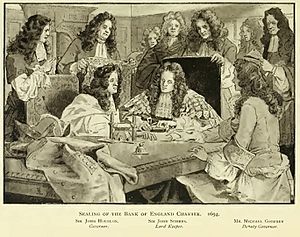Central bank facts for kids
A central bank (or reserve bank) manages a state's currency, money supply, and interest rates.
Central banks usually oversee the commercial banks of their country. It issues the national currency, the nation's money. It controls the overall supply of money. In contrast to a commercial bank, a central bank can increase or decrease the amount of money in the nation.
The oldest central bank is the Bank of England. The largest banks are now the European Central Bank (ECB) and the Federal Reserve of the United States.
Central banks usually also have supervisory powers. These powers are meant to prevent bank runs, and to stop commercial banks and other financial institutions doing reckless or fraudulent things. The relation between central banks and governments varies from country to country.
The chief executive of a central bank is normally known as the Governor, President or Chairman.
Activities and responsibilities

Functions of a central bank may include:
- implementing monetary policies.
- setting the official interest rate – used to manage both inflation and the country's exchange rate – and ensuring that this rate takes effect via a variety of policy mechanisms
- controlling the nation's entire money supply
- the Government's banker and the bankers' bank ("lender of last resort")
- managing the country's foreign exchange and gold reserves and the Government's stock register
- regulating and supervising the banking industry
Monetary policy
Central banks implement a country's chosen monetary policy.
Assets
As of 2016, 75% of the world’s central-bank assets are controlled by four centers in China, the United States, Japan and the eurozone. The central banks of Brazil, Switzerland, Saudi Arabia, the U.K., India and Russia, each account for an average of 2.5 percent. The remaining 107 central banks hold less than 13 percent. According to data compiled by Bloomberg News, the top 10 largest central banks owned $21.4 trillion in assets, a 10 percent increase from 2015.
Images for kids
-
The European Central Bank building in Frankfurt
-
Central bank independence versus inflation. This often cited research published by Alesina and Summers (1993) is used to show why it is important for a nation's central bank (i.e.-monetary authority) to have a high level of independence. This chart shows a clear trend towards a lower inflation rate as the independence of the central bank increases. The generally agreed upon reason independence leads to lower inflation is that politicians have a tendency to create too much money if given the opportunity to do it. The Federal Reserve System in the United States is generally regarded as one of the more independent central banks
-
The Bank of England, established in 1694.
-
The Bank of Finland in Helsinki
-
The headquarters of the People's Bank of China (established in 1948) in Beijing.
See also
 In Spanish: Banco central para niños
In Spanish: Banco central para niños








